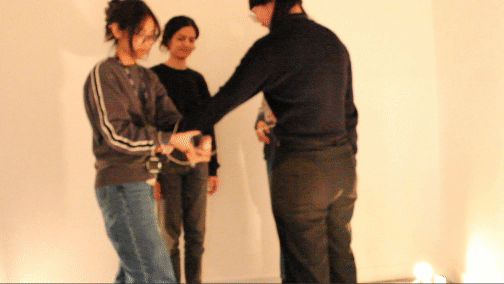Get in touch with me at ananyamanishdesigns@gmail.com

Co-presence
In collaboration with BitterSuite
Design Brief
Design a way to spread feelings.
Design Phase 3
Designing sensory experience for emotional contagion and analysing it's impact in the real world.
Designers
Lyu Min, Rania, Jaitong Zhang, Fateema Nadeem, Ananya Manish
Research Methodologies
Bodystorming, Participatory Design Research
Key words
Auditory Heartbeat, Light Dynamics, Structured Play, Emotional Web
Empathy through Heartbeats
Empathy is fundamental of social understanding and connection, yet empathetic connections are not always easy to find. An academic paper by R. Michael Winters pursuing Doctor of Philosophy in the School of Music at Georgia Institute of Technology discussed the “Empathetic Effects of Auditory Heartbeats” from a neurophysiological point of view (Winters, R. 2020). Winters' findings reveal:
-
The auditory presence of a heartbeat not only impacts the listener's physiology but, when listened to with empathy, can significantly deepen emotional connections.
-
The tempo of the heartbeat and expression in the eyes are affectively meaningful signals that may have equal power to influence affective empathy.
-
Auditory heartbeat functions as an “exteroceptive” stimulus, which can help regulate the listener’s own interoceptive processing. This could be helpful in cases of anxiety.

Concept Development
Our initial experiments felt somewhat flat and lacked clarity. The breakthrough came unexpectedly during a brainstorming session that turned playful. The mere act of passing a ball around; Sitting in a circle, choosing a person to pass, making eye-contact, passing and catching the ball, led us to an interesting research question.
“Could we trace empathetic connections more tangibly through play?”


Thus, we designed an experience based on Winters’ research and our team's insights, centered around the physical sharing of emotions through the act of passing a ball of yarn. We hypothesised that the experience will be the physicalisation of the emotional connection between humans, creating a physical and psychological emotional web.

Alterations to our previous experimentations
Recorded Heartbeat Sound
We decided to opt for recorded heartbeats instead of asking participants to vocalise/ visualise heartbeat. This allowed for a more authentic and controlled auditory experience. It helped us facilitate an auditory journey for participants using gradual variation in the tempo of teh heartbeat.

Lighting Dynamics
The strategic use of lighting, particularly red light known for inducing positive biochemical responses, was employed to set a playful mood.
Structured Play
Incorporating play allowed for unexpected participant behaviours that enhanced the emotional spread. It also gave context for the experience.
The "Connect" Experience
During our experimentation, we tested out various setups to enhance the experience. Initially we conducted the experiment while standing, only to discover that it created a sense of separation when one person wasn't intertwined while the others were weaving themselves together. This feeling wasn't as noticeable when we tried the experiment while sitting down.

In another attempt we used the yellow light to mark the experience space, although it was’t strong enough to evoke any sensory emotions.
Instructions for Connect
-
Gather in a circle with five other participants.
-
One person volunteers to start the activity by picking up the yarn.
-
Pass the yarn to another participant, and continue passing it around the circle.
-
As you pass the yarn, intertwine it between yourself and others, creating connections.
-
Listen to the heartbeat sound in the background as you weave the yarn, marking the passage of time.
-
When the yarn reaches its end, the heartbeat sound will end, signalling the end of the activity.
-
Reflect on the experience as you feel the connections slowly unwind.


Observations and Insights
After our tests, we found the patterns of entanglement among participants particularly fascinating. The physical web was more intricate among those who knew each other, suggesting the complexity of deciding how and with whom to form connections, and whether these connections would be perceived positively or negatively. We observed participants started synchronising their behaviour as they were entangling each other. There was a shared rhythm in their actions.

The combination of red lighting and the varying heartbeat tempos introduced unique emotional dynamics. Notably, as the heartbeat's tempo increased, participants became more animated, both in their ideas and movements. Our final outcome was a connecting experience physicalising the spreading of emotions. When asked participants did feel heightened emotions and emotional contagion during the experience.
However, the conclusion of the experience didn't unfold as planned. We struggled to find a clear way to conclude the activity, aiming for a moment that would allow participants to recognize, celebrate, and then release their shared connections. The intended signal to end—the stopping of the heartbeat sound—was not as clear to participants as we had hoped, leading to some confusion.
This five-week research process holds potential to design for experiences that foster empathetic connections and emotional contagion. The behavioral changes and responses we noted during experimentations affirm that our conceptual direction was aligned with our objectives. However, to refine the experience further, more user testing is needed to achieve a fully realized conclusion.


References
Winters, R. (2020). EMPATHIC EFFECTS OF AUDITORY HEARTBEATS: A NEUROPHYSIOLOGICAL INVESTIGATION A Dissertation Presented to The Academic Faculty. [online] Available at: https://repository.gatech.edu/server/api/core/bitstreams/57f69a33-9de3-4e82-a69b-a0291784cf24/content [Accessed 16 Apr. 2024].
Akihiro Koreki, Goeta, D., Ricciardi, L., Eilon, T., Chen, J., Critchley, H.D., Garfinkel, S.N., Edwards, M. and Mahinda Yogarajah (2022). The relationship between interoception and agency and its modulation by heartbeats: an exploratory study. Scientific Reports, 12(1). doi:https://doi.org/10.1038/s41598-022-16569-6.
Salem, M. (n.d.). The Heart, Mind and Spirit. [online] Available at: https://www.rcpsych.ac.uk/docs/default-source/members/sigs/spirituality-spsig/spirituality-special-interest-group-publications-professor-mohamed-omar-salem-the-heart-mind-and-spirit.pdf?sfvrsn=47fea910_2#:~:text=Research%20has%20shown%20that%20the [Accessed 16 Apr. 2024].
Al, E., Iliopoulos, F., Forschack, N., Nierhaus, T., Grund, M., Motyka, P., Gaebler, M., Nikulin, V.V. and Villringer, A. (2020). Heart–brain interactions shape somatosensory perception and evoked potentials. Proceedings of the National Academy of Sciences, 117(19), pp.10575–10584. doi:https://doi.org/10.1073/pnas.1915629117.
Herrando, C. and Constantinides, E. (2021). Emotional Contagion: A Brief Overview and Future Directions. Frontiers in Psychology, [online] 12. doi:https://doi.org/10.3389/fpsyg.2021.712606.
De, M. (2010). The age of empathy : nature’s lessons for a kinder society. New York: Three Rivers Press.